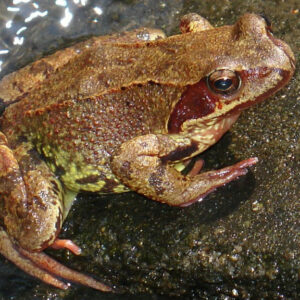The Common Frog
The Common Frog
Rana temporaria
Also associated with Witches and Halloween, the Common Frog is the most recognisable of all our amphibians
A regular visitor to all our ponds and gardens across the UK, where it feasts on slugs and snails, so very much the gardener’s best friend! As a result I now have a new relationship with the frog and am delighted to find it in my garden
In our gardens from February to October
They will be preparing for hibernation this Winter, finding refuge in log piles, in compost heaps and pond mud
Measuring about 8 – 13 cm in length, they live for up to five to ten years. The female is larger in size than the male. With a smooth skin, they vary in colour enormously ranging from green to brown, and even red to yellow, with banded long back legs, with webbed feet and with a dark, mask like band around the eyes. They are able to adapt their skin colour to blend in with their surroundings
As amphibians, the Common Frog breeds in ponds or lakes during the Spring, where they lay their eggs in great rafts of spawn. As carnivores the Common Frog feeds on a wide variety of invertebrates such as flies and worms and smaller amphibians. The rest of the year they can be found feeding in woodland habitat, hedgerows, tussocky grasslands and gardens
In order to breed the male Frog croaks to attract the attention of a female, when the male has found a mate, it grasps onto the back of the female by swollen nuptial pads on its forelegs, in a mating embrace known as amplexus
Eggs are laid in clusters of spawn in shallow water. Encased in a clear jelly, the eggs are small and black and up to 2,000 can be laid in one clump. After about three weeks the tadpoles emerge. They feed on algae in the water and take up to 16 weeks to become froglets, growing legs and absorbing their tales
Found all over the country except certain Scottish Islands, and some of the Isles of Scilly and the Channel Islands
Common Frog numbers are in decline due to loss of breeding habitat, many ponds and lakes are being reclaimed for developement sites. This species is often killed on the road when travelling to breeding sites and disease is another factor contributing to their decline
If you want to help please consider creating a pond in your garden
